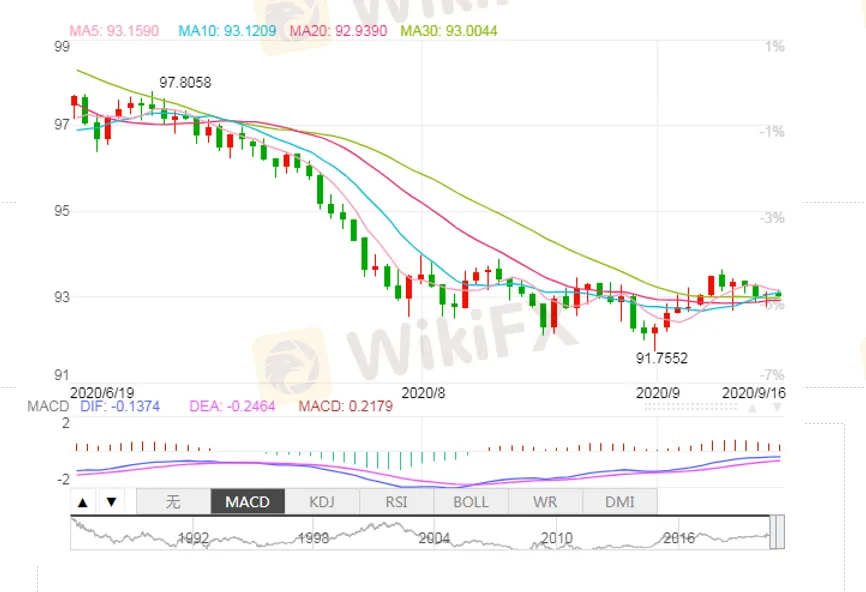简体中文
繁體中文
English
Pусский
日本語
ภาษาไทย
Tiếng Việt
Bahasa Indonesia
Español
हिन्दी
Filippiiniläinen
Français
Deutsch
Português
Türkçe
한국어
العربية
USD May Encounter New Round of Depreciation
Abstract:USDX has experienced a sharper volatility since this year. And it continues dropping despite of the temporary rally in US stock market stimulated by the hawkish fiscal and monetary policy.
WikiFX News (6 Oct.) - USDX has experienced a sharper volatility since this year. And it continues dropping despite of the temporary rally in US stock market stimulated by the hawkish fiscal and monetary policy.
In its Statement on Longer-Run Goals and Monetary Strategy, the Federal Open Market Committee (FOMC) will put more focus on the employment, reduce the inflation intolerance, and lower the long-term interest rate expectations.
In a CME FedWatch tools analysis, the Fed will keep 100% probability of maintaining an interest rate ranging 0-0.25% before March 2021; According to the Dot-Plot chart released in the FOMC meeting in June, the Fed official expected not to increase interest rate at least until the end of 2022. All these explain that it will take a long time for the US to recover its economy. At the same time, without the support by economic fundamentals, USDX is hard to rise.
Furthermore, the eurozone will attract more capital because of the increase in euro, which may challenge USD‘s position of the world’s reserve currency. The euro accounts for 57.6% of the USDX. Therefore, a rising euro is possibly to lead to a depreciated USD, which is expected to enter into a new round of depreciation.
All the above is provided by WikiFX, a platform world-renowned for foreign exchange information. For details, please download the WikiFX App: bit.ly/WIKIFX

Chart: USDX Trend
Disclaimer:
The views in this article only represent the author's personal views, and do not constitute investment advice on this platform. This platform does not guarantee the accuracy, completeness and timeliness of the information in the article, and will not be liable for any loss caused by the use of or reliance on the information in the article.
Read more

Economic and Political Shifts Impact Global Markets Part 2
Recent developments include President Biden's potential re-election reconsideration, Asia-Pacific market highs, PwC's auditing issues in China, potential acquisitions in the energy and retail sectors, geopolitical tensions, and regulatory actions impacting markets. Key impacts include fluctuations in USD, CNY, CAD, TWD, EUR, GBP, and AUD, with significant effects on stock markets across the US, Asia, and Europe.

Economic and Political Shifts Impact Global Markets Part 1
Recent developments include President Biden's potential re-election reconsideration, Asia-Pacific market highs, PwC's auditing issues in China, potential acquisitions in the energy and retail sectors, geopolitical tensions, and regulatory actions impacting markets. Key impacts include fluctuations in USD, CNY, CAD, TWD, EUR, GBP, and AUD, with significant effects on stock markets across the US, Asia, and Europe.

GEMFOREX - weekly analysis
Top 5 things to watch in markets in the week ahead

GEMFOREX - weekly analysis
The week ahead: 5 things to watch
WikiFX Broker
Latest News
Cinkciarz.pl Under Fire: Frozen Accounts, Missing Funds
First Unfair Trading Case Reported Under South Korea’s Virtual Asset User Protection Act
“Predict and Win” Big Rewards! Join the Contest Now
Mitrade Ensures Trader Protection Backed by Lloyd's of London
Rs. 1 Billion Ponzi Scam: 3K Investors Duped by Engineers
Upbit Faces Severe Penalties for AML and KYC Violations
Yen's Weakness Raises Concerns
Why the Federal Reserve Is So Important
Boerse Stuttgart Digital Secures EU-Wide MiCAR Crypto License
South Africa's FSCA Warns against CMFX Trading
Currency Calculator






